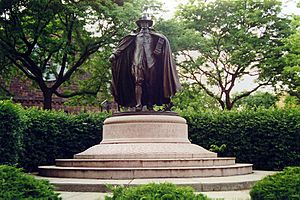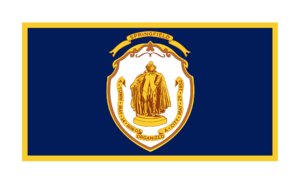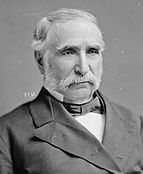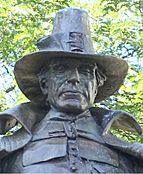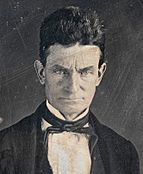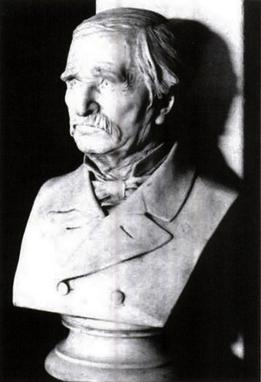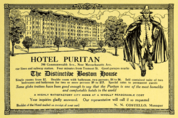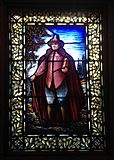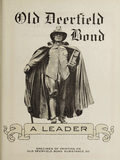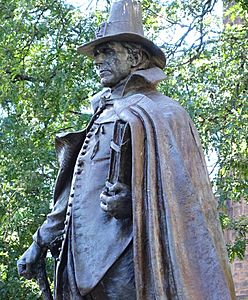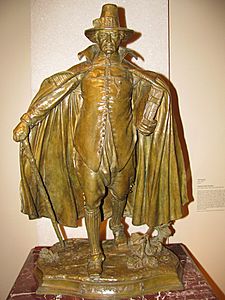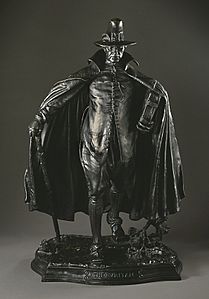The Puritan (Springfield, Massachusetts) facts for kids
The Puritan is a famous bronze statue located in Springfield, Massachusetts. It was created by the talented sculptor Augustus Saint-Gaudens. This statue became so popular that many copies were made for other cities, museums, and private collections around the world. It even became an official symbol of Springfield and is on the city's flag! The statue was first placed in Stearns Square. Since 1899, it has stood at the corner of Chestnut and State Street, right next to The Quadrangle, a cultural center.
Contents
How the Statue Came to Be
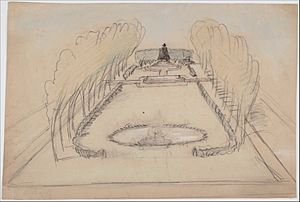
In 1881, a wealthy railroad owner and congressman named Chester W. Chapin asked Augustus Saint-Gaudens to create the statue. Mr. Chapin wanted a bronze statue of his ancestor, Deacon Samuel Chapin. Deacon Samuel Chapin (1595–1675) was one of the first people to settle in Springfield. At that time, Springfield was a very rich city, known for its factories and new inventions.
The statue was made in Philadelphia and was shown to the public on Thanksgiving, November 24, 1887. It was first placed in Stearns Square. The design of the square, including the statue, was a team effort by Saint-Gaudens and famous architect Stanford White. However, in 1899, the statue was moved to Merrick Park. This park later became part of Springfield's Quadrangle cultural area. The statue has been there ever since. Even before it was first shown, Saint-Gaudens thought the current spot would be better for the statue.
In 1983, there was a brief discussion about moving the statue back to Stearns Square. Some people wanted to restore the original area. But most people, including the mayor at the time, Richard Neal, and Deacon Chapin's family, did not want it moved. They said the statue had become an important part of the Quadrangle's museums. They also mentioned that the statue was moved in 1899 to protect it from damage.
Today, you can find The Puritan next to the Springfield City Library. The base of the statue has these words carved into it: "1595 Anno Domini 1675, Deacon Samuel Chapin, One Of The Founders Of Springfield"
Who the Statue Looks Like
When the statue was being designed, there were no real pictures of Deacon Samuel Chapin. The Saint-Gaudens National Historical Park says that the face of the statue was modeled after Deacon Chapin's descendant, Chester W. Chapin. Saint-Gaudens himself said he used Mr. Chapin's face as his model. However, some people at the time said the statue was "no portrait of any Chapin, but a mix of the family type."
In 2014, a historian named Stephen Jendrysik suggested a different idea. He thought the statue's face might be a hidden tribute to John Brown. John Brown was a famous person who fought against slavery. He was also a direct descendant of Deacon Chapin. Chester Chapin, who ordered the statue, even helped pay for soldiers' uniforms at the start of the American Civil War. The Chapin family in Springfield also played a big part in the Underground Railroad. This was a secret network that helped enslaved people escape to freedom.
John Brown was a very important figure who helped start the fight that ended slavery. He was known for organizing the "Subterranean Pass Way" in Springfield. This was a strong part of the Underground Railroad. He met with other important leaders like Frederick Douglass and Harriet Tubman in Springfield.
Historians have often called John Brown "The Puritan." This is because he was inspired by early Puritan thinkers. During the Civil War, Puritan beliefs were seen as a reason for the movement to end slavery.
Saint-Gaudens admired John Brown. He is also famous for his statues honoring the Civil War. One of his most famous works is the Robert Gould Shaw Memorial in Boston. This memorial honors the 54th Massachusetts Infantry Regiment, the first African-American regiment in the Union Army during the Civil War. While Saint-Gaudens never said the statue was a tribute to John Brown, many people have noticed that the statue's face looks a lot like John Brown's. So, the statue might honor both the influence of Puritanism in early New England and the fight against slavery in Springfield.
Why the Statue Became So Popular
The statue was very popular with the public. Because of this, Saint-Gaudens decided to make smaller copies of it. He called these smaller versions The Puritan. He knew this would be a good way to earn more money. Today, more than 25 slightly different copies of this statue can be found in museums, art galleries, universities, and private collections worldwide. Some famous places with copies include the Museum of Fine Arts in Boston and the Metropolitan Museum of Art in New York City.
The New England Society of Pennsylvanians asked Saint-Gaudens to make another copy for Philadelphia, Pennsylvania. For this copy, Saint-Gaudens made some changes to the figure's clothes and face. He wanted it to look more like a typical New England person. He said, "For the head in the original statue, I used Mr. Chapin's head as a model. But Mr. Chapin's face is round. So, for the Philadelphia work, I changed the features completely, making them long, like the New England type." This copy was named The Pilgrim. It was first placed near City Hall and then moved to Fairmount Park in 1920.
An expert in coins and art history, Cornelius Vermeule, thought that The Puritan statue influenced another artist. He believed it helped Cyrus E. Dallin design the portrait of Governor William Bradford for the 1920-1921 Pilgrim Tercentenary half dollar coin. This coin shows a Puritan figure holding a Bible under his left arm, similar to The Puritan statue.
Gallery
-
Part of The Puritan by Augustus Saint-Gaudens
-
A copy of the larger sculpture by Augustus Saint-Gaudens in the Smithsonian, with differences from the Springfield original.
-
A copy of the statue in the Los Angeles County Museum of Art


